Comprehensive Analysis: Milk and Milk Products, Nutritional Aspects
VerifiedAdded on 2022/08/17
|15
|4688
|50
Report
AI Summary
This report provides a comprehensive overview of milk and its products, delving into their composition, processing methods, and nutritional benefits. It begins by defining milk and its derivatives, detailing the composition of cow's milk, including water, proteins, minerals, lactose, and fat. The report then explores the components of milk, such as milk fat, casein, and whey protein, highlighting their unique properties and roles. It discusses the carbohydrates, vitamins, and minerals present in milk, emphasizing the importance of calcium, potassium, and vitamins A, D, and B12. The report also addresses lactose intolerance and its management. Furthermore, it covers the processing of milk, including clarification, pasteurization, and homogenization, explaining the purpose and methods of each step. Finally, it examines various related milk products like Vitamin D milk, low-sodium milk, and cheese, yogurt, butter, and ice cream, offering insights into their production and nutritional aspects. This report serves as a valuable resource for understanding the science and benefits of milk and dairy products.
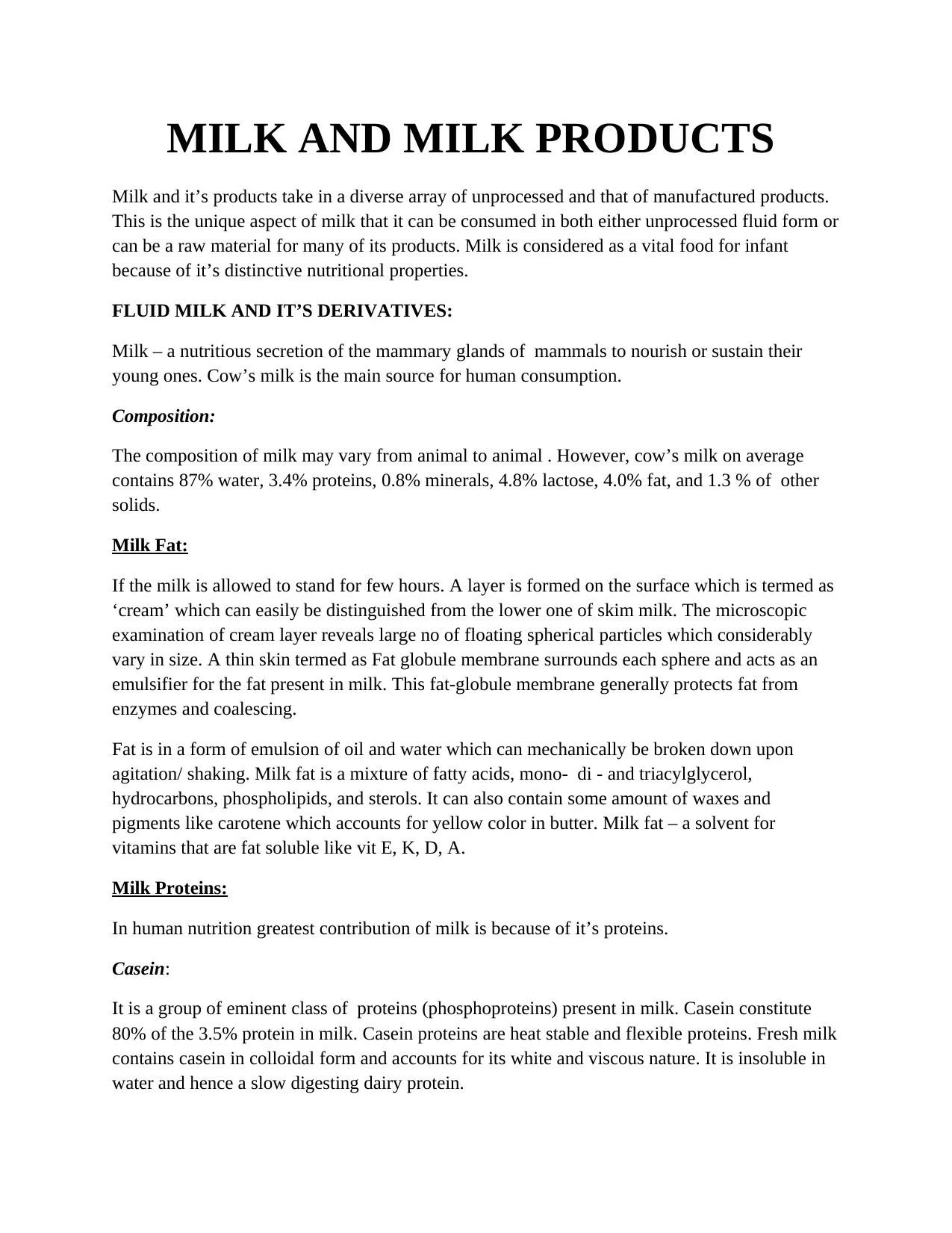
MILK AND MILK PRODUCTS
Milk and it’s products take in a diverse array of unprocessed and that of manufactured products.
This is the unique aspect of milk that it can be consumed in both either unprocessed fluid form or
can be a raw material for many of its products. Milk is considered as a vital food for infant
because of it’s distinctive nutritional properties.
FLUID MILK AND IT’S DERIVATIVES:
Milk – a nutritious secretion of the mammary glands of mammals to nourish or sustain their
young ones. Cow’s milk is the main source for human consumption.
Composition:
The composition of milk may vary from animal to animal . However, cow’s milk on average
contains 87% water, 3.4% proteins, 0.8% minerals, 4.8% lactose, 4.0% fat, and 1.3 % of other
solids.
Milk Fat:
If the milk is allowed to stand for few hours. A layer is formed on the surface which is termed as
‘cream’ which can easily be distinguished from the lower one of skim milk. The microscopic
examination of cream layer reveals large no of floating spherical particles which considerably
vary in size. A thin skin termed as Fat globule membrane surrounds each sphere and acts as an
emulsifier for the fat present in milk. This fat-globule membrane generally protects fat from
enzymes and coalescing.
Fat is in a form of emulsion of oil and water which can mechanically be broken down upon
agitation/ shaking. Milk fat is a mixture of fatty acids, mono- di - and triacylglycerol,
hydrocarbons, phospholipids, and sterols. It can also contain some amount of waxes and
pigments like carotene which accounts for yellow color in butter. Milk fat – a solvent for
vitamins that are fat soluble like vit E, K, D, A.
Milk Proteins:
In human nutrition greatest contribution of milk is because of it’s proteins.
Casein:
It is a group of eminent class of proteins (phosphoproteins) present in milk. Casein constitute
80% of the 3.5% protein in milk. Casein proteins are heat stable and flexible proteins. Fresh milk
contains casein in colloidal form and accounts for its white and viscous nature. It is insoluble in
water and hence a slow digesting dairy protein.
Milk and it’s products take in a diverse array of unprocessed and that of manufactured products.
This is the unique aspect of milk that it can be consumed in both either unprocessed fluid form or
can be a raw material for many of its products. Milk is considered as a vital food for infant
because of it’s distinctive nutritional properties.
FLUID MILK AND IT’S DERIVATIVES:
Milk – a nutritious secretion of the mammary glands of mammals to nourish or sustain their
young ones. Cow’s milk is the main source for human consumption.
Composition:
The composition of milk may vary from animal to animal . However, cow’s milk on average
contains 87% water, 3.4% proteins, 0.8% minerals, 4.8% lactose, 4.0% fat, and 1.3 % of other
solids.
Milk Fat:
If the milk is allowed to stand for few hours. A layer is formed on the surface which is termed as
‘cream’ which can easily be distinguished from the lower one of skim milk. The microscopic
examination of cream layer reveals large no of floating spherical particles which considerably
vary in size. A thin skin termed as Fat globule membrane surrounds each sphere and acts as an
emulsifier for the fat present in milk. This fat-globule membrane generally protects fat from
enzymes and coalescing.
Fat is in a form of emulsion of oil and water which can mechanically be broken down upon
agitation/ shaking. Milk fat is a mixture of fatty acids, mono- di - and triacylglycerol,
hydrocarbons, phospholipids, and sterols. It can also contain some amount of waxes and
pigments like carotene which accounts for yellow color in butter. Milk fat – a solvent for
vitamins that are fat soluble like vit E, K, D, A.
Milk Proteins:
In human nutrition greatest contribution of milk is because of it’s proteins.
Casein:
It is a group of eminent class of proteins (phosphoproteins) present in milk. Casein constitute
80% of the 3.5% protein in milk. Casein proteins are heat stable and flexible proteins. Fresh milk
contains casein in colloidal form and accounts for its white and viscous nature. It is insoluble in
water and hence a slow digesting dairy protein.
Secure Best Marks with AI Grader
Need help grading? Try our AI Grader for instant feedback on your assignments.
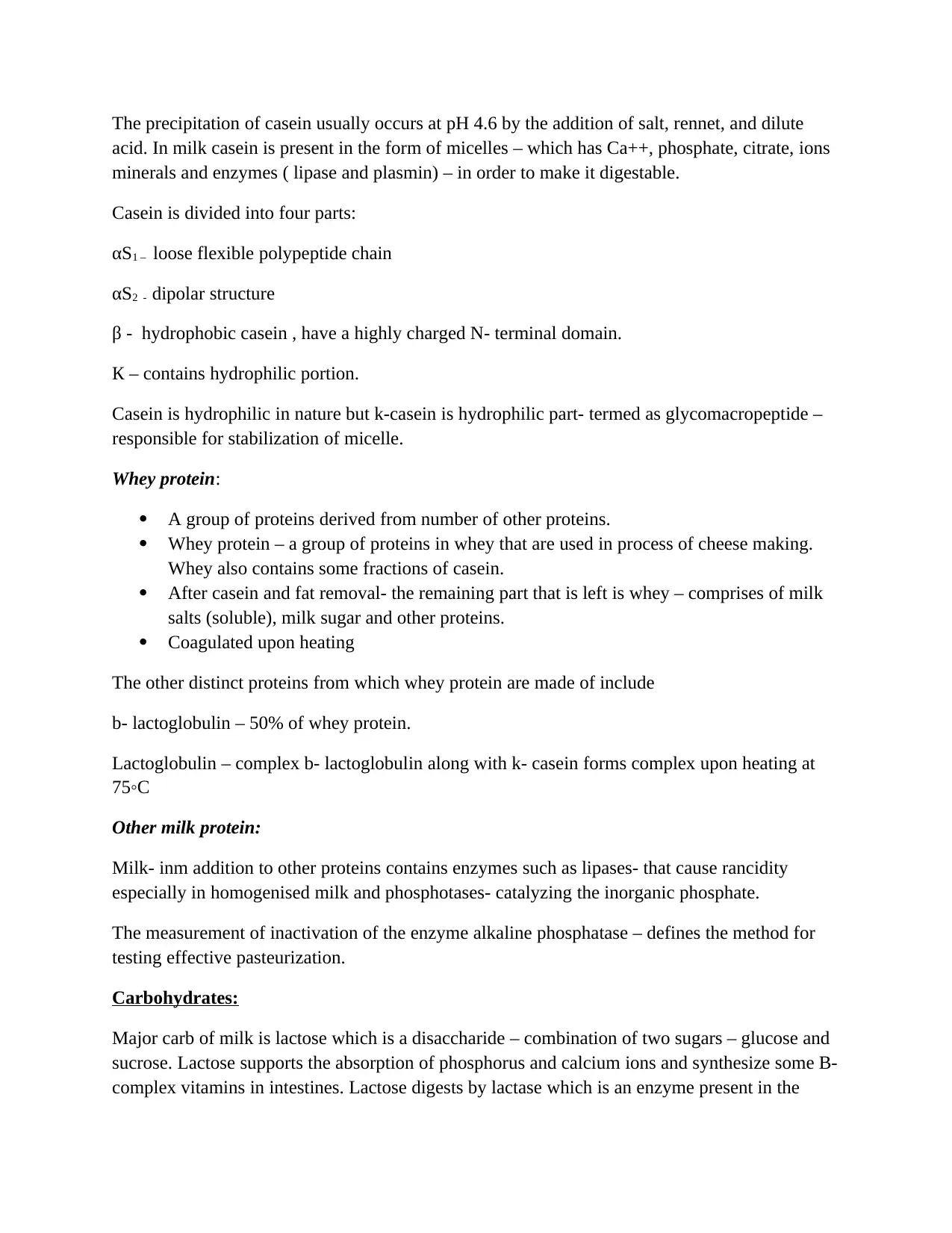
The precipitation of casein usually occurs at pH 4.6 by the addition of salt, rennet, and dilute
acid. In milk casein is present in the form of micelles – which has Ca++, phosphate, citrate, ions
minerals and enzymes ( lipase and plasmin) – in order to make it digestable.
Casein is divided into four parts:
αS1 – loose flexible polypeptide chain
αS2 - dipolar structure
β - hydrophobic casein , have a highly charged N- terminal domain.
К – contains hydrophilic portion.
Casein is hydrophilic in nature but k-casein is hydrophilic part- termed as glycomacropeptide –
responsible for stabilization of micelle.
Whey protein:
A group of proteins derived from number of other proteins.
Whey protein – a group of proteins in whey that are used in process of cheese making.
Whey also contains some fractions of casein.
After casein and fat removal- the remaining part that is left is whey – comprises of milk
salts (soluble), milk sugar and other proteins.
Coagulated upon heating
The other distinct proteins from which whey protein are made of include
b- lactoglobulin – 50% of whey protein.
Lactoglobulin – complex b- lactoglobulin along with k- casein forms complex upon heating at
75◦C
Other milk protein:
Milk- inm addition to other proteins contains enzymes such as lipases- that cause rancidity
especially in homogenised milk and phosphotases- catalyzing the inorganic phosphate.
The measurement of inactivation of the enzyme alkaline phosphatase – defines the method for
testing effective pasteurization.
Carbohydrates:
Major carb of milk is lactose which is a disaccharide – combination of two sugars – glucose and
sucrose. Lactose supports the absorption of phosphorus and calcium ions and synthesize some B-
complex vitamins in intestines. Lactose digests by lactase which is an enzyme present in the
acid. In milk casein is present in the form of micelles – which has Ca++, phosphate, citrate, ions
minerals and enzymes ( lipase and plasmin) – in order to make it digestable.
Casein is divided into four parts:
αS1 – loose flexible polypeptide chain
αS2 - dipolar structure
β - hydrophobic casein , have a highly charged N- terminal domain.
К – contains hydrophilic portion.
Casein is hydrophilic in nature but k-casein is hydrophilic part- termed as glycomacropeptide –
responsible for stabilization of micelle.
Whey protein:
A group of proteins derived from number of other proteins.
Whey protein – a group of proteins in whey that are used in process of cheese making.
Whey also contains some fractions of casein.
After casein and fat removal- the remaining part that is left is whey – comprises of milk
salts (soluble), milk sugar and other proteins.
Coagulated upon heating
The other distinct proteins from which whey protein are made of include
b- lactoglobulin – 50% of whey protein.
Lactoglobulin – complex b- lactoglobulin along with k- casein forms complex upon heating at
75◦C
Other milk protein:
Milk- inm addition to other proteins contains enzymes such as lipases- that cause rancidity
especially in homogenised milk and phosphotases- catalyzing the inorganic phosphate.
The measurement of inactivation of the enzyme alkaline phosphatase – defines the method for
testing effective pasteurization.
Carbohydrates:
Major carb of milk is lactose which is a disaccharide – combination of two sugars – glucose and
sucrose. Lactose supports the absorption of phosphorus and calcium ions and synthesize some B-
complex vitamins in intestines. Lactose digests by lactase which is an enzyme present in the
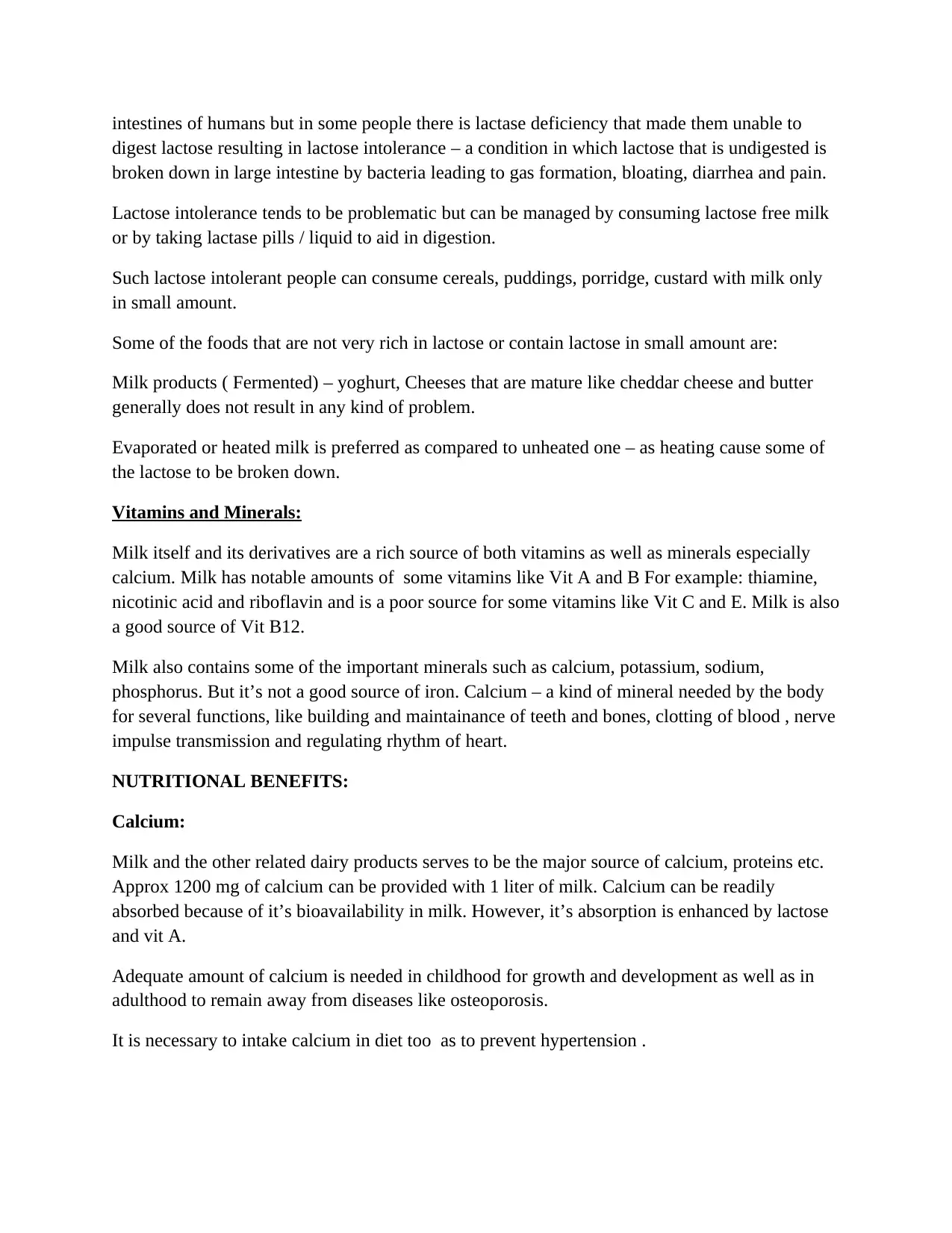
intestines of humans but in some people there is lactase deficiency that made them unable to
digest lactose resulting in lactose intolerance – a condition in which lactose that is undigested is
broken down in large intestine by bacteria leading to gas formation, bloating, diarrhea and pain.
Lactose intolerance tends to be problematic but can be managed by consuming lactose free milk
or by taking lactase pills / liquid to aid in digestion.
Such lactose intolerant people can consume cereals, puddings, porridge, custard with milk only
in small amount.
Some of the foods that are not very rich in lactose or contain lactose in small amount are:
Milk products ( Fermented) – yoghurt, Cheeses that are mature like cheddar cheese and butter
generally does not result in any kind of problem.
Evaporated or heated milk is preferred as compared to unheated one – as heating cause some of
the lactose to be broken down.
Vitamins and Minerals:
Milk itself and its derivatives are a rich source of both vitamins as well as minerals especially
calcium. Milk has notable amounts of some vitamins like Vit A and B For example: thiamine,
nicotinic acid and riboflavin and is a poor source for some vitamins like Vit C and E. Milk is also
a good source of Vit B12.
Milk also contains some of the important minerals such as calcium, potassium, sodium,
phosphorus. But it’s not a good source of iron. Calcium – a kind of mineral needed by the body
for several functions, like building and maintainance of teeth and bones, clotting of blood , nerve
impulse transmission and regulating rhythm of heart.
NUTRITIONAL BENEFITS:
Calcium:
Milk and the other related dairy products serves to be the major source of calcium, proteins etc.
Approx 1200 mg of calcium can be provided with 1 liter of milk. Calcium can be readily
absorbed because of it’s bioavailability in milk. However, it’s absorption is enhanced by lactose
and vit A.
Adequate amount of calcium is needed in childhood for growth and development as well as in
adulthood to remain away from diseases like osteoporosis.
It is necessary to intake calcium in diet too as to prevent hypertension .
digest lactose resulting in lactose intolerance – a condition in which lactose that is undigested is
broken down in large intestine by bacteria leading to gas formation, bloating, diarrhea and pain.
Lactose intolerance tends to be problematic but can be managed by consuming lactose free milk
or by taking lactase pills / liquid to aid in digestion.
Such lactose intolerant people can consume cereals, puddings, porridge, custard with milk only
in small amount.
Some of the foods that are not very rich in lactose or contain lactose in small amount are:
Milk products ( Fermented) – yoghurt, Cheeses that are mature like cheddar cheese and butter
generally does not result in any kind of problem.
Evaporated or heated milk is preferred as compared to unheated one – as heating cause some of
the lactose to be broken down.
Vitamins and Minerals:
Milk itself and its derivatives are a rich source of both vitamins as well as minerals especially
calcium. Milk has notable amounts of some vitamins like Vit A and B For example: thiamine,
nicotinic acid and riboflavin and is a poor source for some vitamins like Vit C and E. Milk is also
a good source of Vit B12.
Milk also contains some of the important minerals such as calcium, potassium, sodium,
phosphorus. But it’s not a good source of iron. Calcium – a kind of mineral needed by the body
for several functions, like building and maintainance of teeth and bones, clotting of blood , nerve
impulse transmission and regulating rhythm of heart.
NUTRITIONAL BENEFITS:
Calcium:
Milk and the other related dairy products serves to be the major source of calcium, proteins etc.
Approx 1200 mg of calcium can be provided with 1 liter of milk. Calcium can be readily
absorbed because of it’s bioavailability in milk. However, it’s absorption is enhanced by lactose
and vit A.
Adequate amount of calcium is needed in childhood for growth and development as well as in
adulthood to remain away from diseases like osteoporosis.
It is necessary to intake calcium in diet too as to prevent hypertension .
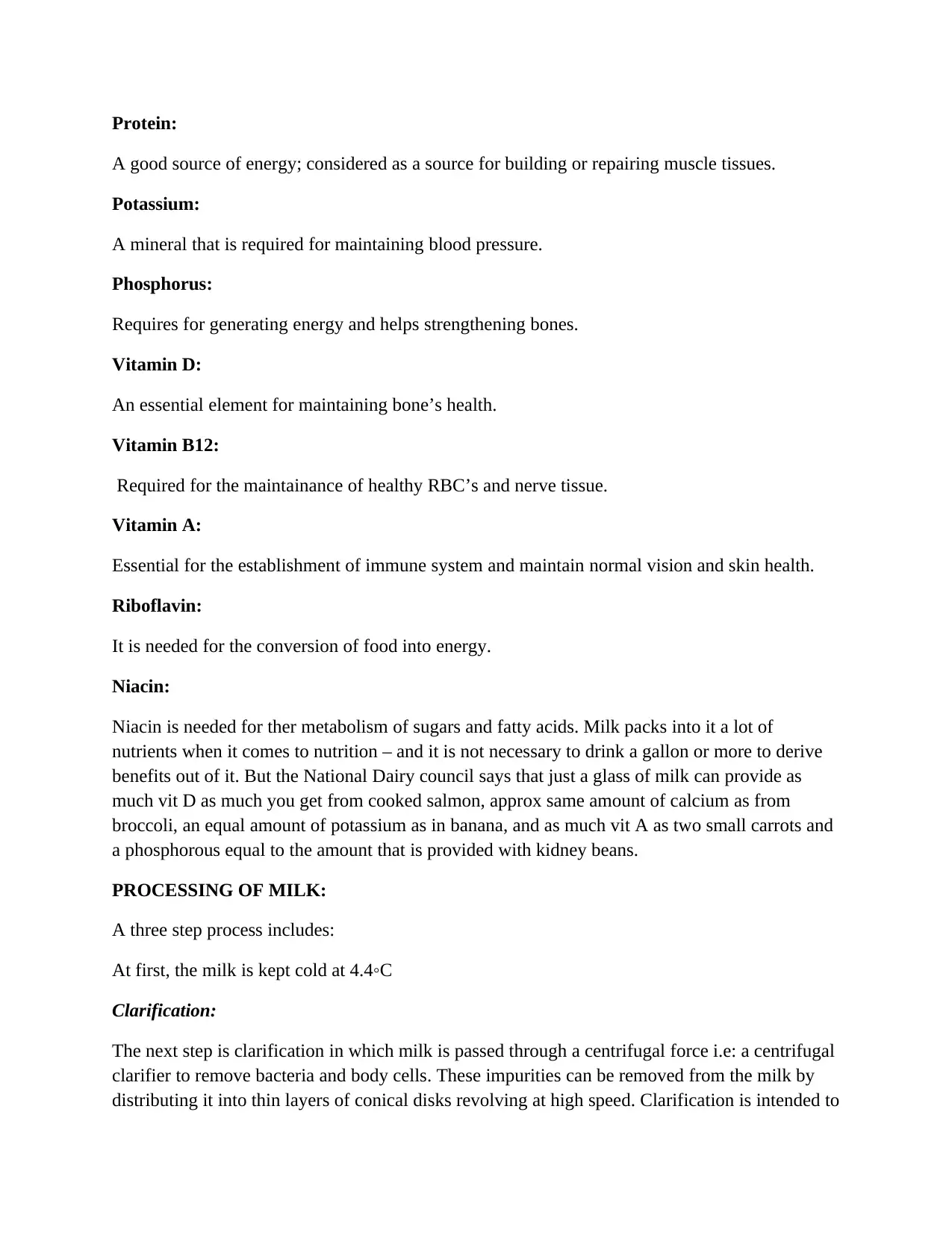
Protein:
A good source of energy; considered as a source for building or repairing muscle tissues.
Potassium:
A mineral that is required for maintaining blood pressure.
Phosphorus:
Requires for generating energy and helps strengthening bones.
Vitamin D:
An essential element for maintaining bone’s health.
Vitamin B12:
Required for the maintainance of healthy RBC’s and nerve tissue.
Vitamin A:
Essential for the establishment of immune system and maintain normal vision and skin health.
Riboflavin:
It is needed for the conversion of food into energy.
Niacin:
Niacin is needed for ther metabolism of sugars and fatty acids. Milk packs into it a lot of
nutrients when it comes to nutrition – and it is not necessary to drink a gallon or more to derive
benefits out of it. But the National Dairy council says that just a glass of milk can provide as
much vit D as much you get from cooked salmon, approx same amount of calcium as from
broccoli, an equal amount of potassium as in banana, and as much vit A as two small carrots and
a phosphorous equal to the amount that is provided with kidney beans.
PROCESSING OF MILK:
A three step process includes:
At first, the milk is kept cold at 4.4◦C
Clarification:
The next step is clarification in which milk is passed through a centrifugal force i.e: a centrifugal
clarifier to remove bacteria and body cells. These impurities can be removed from the milk by
distributing it into thin layers of conical disks revolving at high speed. Clarification is intended to
A good source of energy; considered as a source for building or repairing muscle tissues.
Potassium:
A mineral that is required for maintaining blood pressure.
Phosphorus:
Requires for generating energy and helps strengthening bones.
Vitamin D:
An essential element for maintaining bone’s health.
Vitamin B12:
Required for the maintainance of healthy RBC’s and nerve tissue.
Vitamin A:
Essential for the establishment of immune system and maintain normal vision and skin health.
Riboflavin:
It is needed for the conversion of food into energy.
Niacin:
Niacin is needed for ther metabolism of sugars and fatty acids. Milk packs into it a lot of
nutrients when it comes to nutrition – and it is not necessary to drink a gallon or more to derive
benefits out of it. But the National Dairy council says that just a glass of milk can provide as
much vit D as much you get from cooked salmon, approx same amount of calcium as from
broccoli, an equal amount of potassium as in banana, and as much vit A as two small carrots and
a phosphorous equal to the amount that is provided with kidney beans.
PROCESSING OF MILK:
A three step process includes:
At first, the milk is kept cold at 4.4◦C
Clarification:
The next step is clarification in which milk is passed through a centrifugal force i.e: a centrifugal
clarifier to remove bacteria and body cells. These impurities can be removed from the milk by
distributing it into thin layers of conical disks revolving at high speed. Clarification is intended to
Secure Best Marks with AI Grader
Need help grading? Try our AI Grader for instant feedback on your assignments.
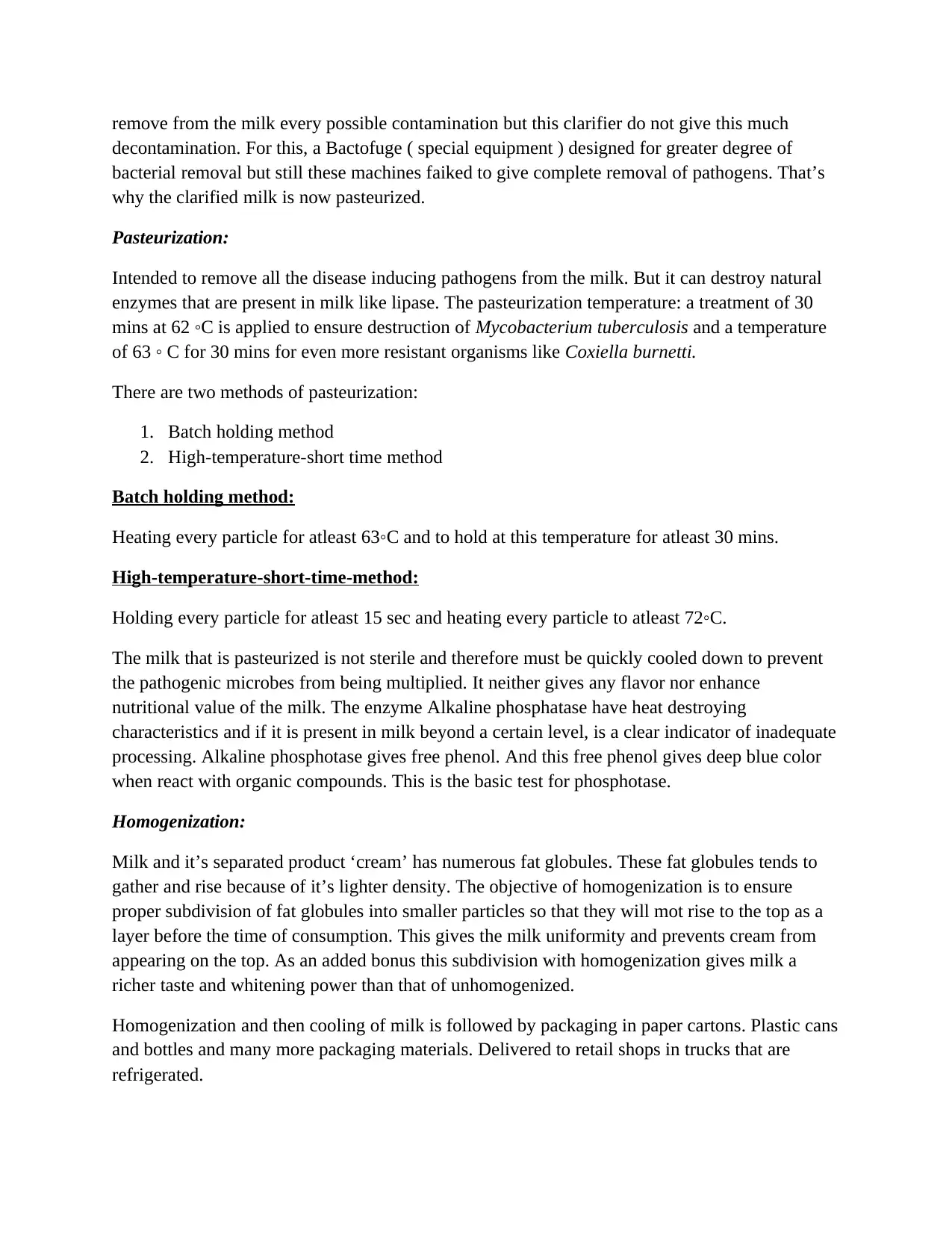
remove from the milk every possible contamination but this clarifier do not give this much
decontamination. For this, a Bactofuge ( special equipment ) designed for greater degree of
bacterial removal but still these machines faiked to give complete removal of pathogens. That’s
why the clarified milk is now pasteurized.
Pasteurization:
Intended to remove all the disease inducing pathogens from the milk. But it can destroy natural
enzymes that are present in milk like lipase. The pasteurization temperature: a treatment of 30
mins at 62 ◦C is applied to ensure destruction of Mycobacterium tuberculosis and a temperature
of 63 ◦ C for 30 mins for even more resistant organisms like Coxiella burnetti.
There are two methods of pasteurization:
1. Batch holding method
2. High-temperature-short time method
Batch holding method:
Heating every particle for atleast 63◦C and to hold at this temperature for atleast 30 mins.
High-temperature-short-time-method:
Holding every particle for atleast 15 sec and heating every particle to atleast 72◦C.
The milk that is pasteurized is not sterile and therefore must be quickly cooled down to prevent
the pathogenic microbes from being multiplied. It neither gives any flavor nor enhance
nutritional value of the milk. The enzyme Alkaline phosphatase have heat destroying
characteristics and if it is present in milk beyond a certain level, is a clear indicator of inadequate
processing. Alkaline phosphotase gives free phenol. And this free phenol gives deep blue color
when react with organic compounds. This is the basic test for phosphotase.
Homogenization:
Milk and it’s separated product ‘cream’ has numerous fat globules. These fat globules tends to
gather and rise because of it’s lighter density. The objective of homogenization is to ensure
proper subdivision of fat globules into smaller particles so that they will mot rise to the top as a
layer before the time of consumption. This gives the milk uniformity and prevents cream from
appearing on the top. As an added bonus this subdivision with homogenization gives milk a
richer taste and whitening power than that of unhomogenized.
Homogenization and then cooling of milk is followed by packaging in paper cartons. Plastic cans
and bottles and many more packaging materials. Delivered to retail shops in trucks that are
refrigerated.
decontamination. For this, a Bactofuge ( special equipment ) designed for greater degree of
bacterial removal but still these machines faiked to give complete removal of pathogens. That’s
why the clarified milk is now pasteurized.
Pasteurization:
Intended to remove all the disease inducing pathogens from the milk. But it can destroy natural
enzymes that are present in milk like lipase. The pasteurization temperature: a treatment of 30
mins at 62 ◦C is applied to ensure destruction of Mycobacterium tuberculosis and a temperature
of 63 ◦ C for 30 mins for even more resistant organisms like Coxiella burnetti.
There are two methods of pasteurization:
1. Batch holding method
2. High-temperature-short time method
Batch holding method:
Heating every particle for atleast 63◦C and to hold at this temperature for atleast 30 mins.
High-temperature-short-time-method:
Holding every particle for atleast 15 sec and heating every particle to atleast 72◦C.
The milk that is pasteurized is not sterile and therefore must be quickly cooled down to prevent
the pathogenic microbes from being multiplied. It neither gives any flavor nor enhance
nutritional value of the milk. The enzyme Alkaline phosphatase have heat destroying
characteristics and if it is present in milk beyond a certain level, is a clear indicator of inadequate
processing. Alkaline phosphotase gives free phenol. And this free phenol gives deep blue color
when react with organic compounds. This is the basic test for phosphotase.
Homogenization:
Milk and it’s separated product ‘cream’ has numerous fat globules. These fat globules tends to
gather and rise because of it’s lighter density. The objective of homogenization is to ensure
proper subdivision of fat globules into smaller particles so that they will mot rise to the top as a
layer before the time of consumption. This gives the milk uniformity and prevents cream from
appearing on the top. As an added bonus this subdivision with homogenization gives milk a
richer taste and whitening power than that of unhomogenized.
Homogenization and then cooling of milk is followed by packaging in paper cartons. Plastic cans
and bottles and many more packaging materials. Delivered to retail shops in trucks that are
refrigerated.
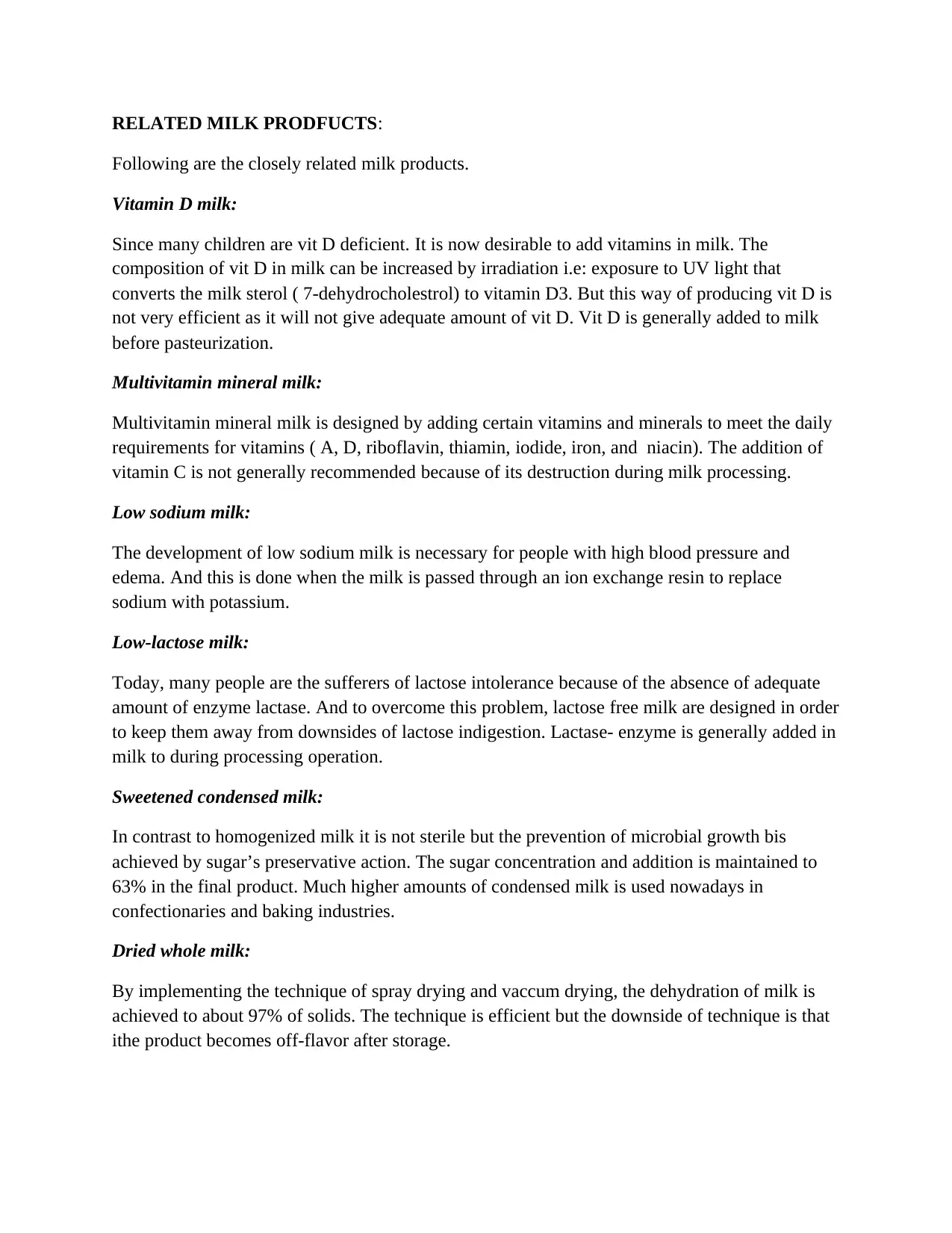
RELATED MILK PRODFUCTS:
Following are the closely related milk products.
Vitamin D milk:
Since many children are vit D deficient. It is now desirable to add vitamins in milk. The
composition of vit D in milk can be increased by irradiation i.e: exposure to UV light that
converts the milk sterol ( 7-dehydrocholestrol) to vitamin D3. But this way of producing vit D is
not very efficient as it will not give adequate amount of vit D. Vit D is generally added to milk
before pasteurization.
Multivitamin mineral milk:
Multivitamin mineral milk is designed by adding certain vitamins and minerals to meet the daily
requirements for vitamins ( A, D, riboflavin, thiamin, iodide, iron, and niacin). The addition of
vitamin C is not generally recommended because of its destruction during milk processing.
Low sodium milk:
The development of low sodium milk is necessary for people with high blood pressure and
edema. And this is done when the milk is passed through an ion exchange resin to replace
sodium with potassium.
Low-lactose milk:
Today, many people are the sufferers of lactose intolerance because of the absence of adequate
amount of enzyme lactase. And to overcome this problem, lactose free milk are designed in order
to keep them away from downsides of lactose indigestion. Lactase- enzyme is generally added in
milk to during processing operation.
Sweetened condensed milk:
In contrast to homogenized milk it is not sterile but the prevention of microbial growth bis
achieved by sugar’s preservative action. The sugar concentration and addition is maintained to
63% in the final product. Much higher amounts of condensed milk is used nowadays in
confectionaries and baking industries.
Dried whole milk:
By implementing the technique of spray drying and vaccum drying, the dehydration of milk is
achieved to about 97% of solids. The technique is efficient but the downside of technique is that
ithe product becomes off-flavor after storage.
Following are the closely related milk products.
Vitamin D milk:
Since many children are vit D deficient. It is now desirable to add vitamins in milk. The
composition of vit D in milk can be increased by irradiation i.e: exposure to UV light that
converts the milk sterol ( 7-dehydrocholestrol) to vitamin D3. But this way of producing vit D is
not very efficient as it will not give adequate amount of vit D. Vit D is generally added to milk
before pasteurization.
Multivitamin mineral milk:
Multivitamin mineral milk is designed by adding certain vitamins and minerals to meet the daily
requirements for vitamins ( A, D, riboflavin, thiamin, iodide, iron, and niacin). The addition of
vitamin C is not generally recommended because of its destruction during milk processing.
Low sodium milk:
The development of low sodium milk is necessary for people with high blood pressure and
edema. And this is done when the milk is passed through an ion exchange resin to replace
sodium with potassium.
Low-lactose milk:
Today, many people are the sufferers of lactose intolerance because of the absence of adequate
amount of enzyme lactase. And to overcome this problem, lactose free milk are designed in order
to keep them away from downsides of lactose indigestion. Lactase- enzyme is generally added in
milk to during processing operation.
Sweetened condensed milk:
In contrast to homogenized milk it is not sterile but the prevention of microbial growth bis
achieved by sugar’s preservative action. The sugar concentration and addition is maintained to
63% in the final product. Much higher amounts of condensed milk is used nowadays in
confectionaries and baking industries.
Dried whole milk:
By implementing the technique of spray drying and vaccum drying, the dehydration of milk is
achieved to about 97% of solids. The technique is efficient but the downside of technique is that
ithe product becomes off-flavor after storage.
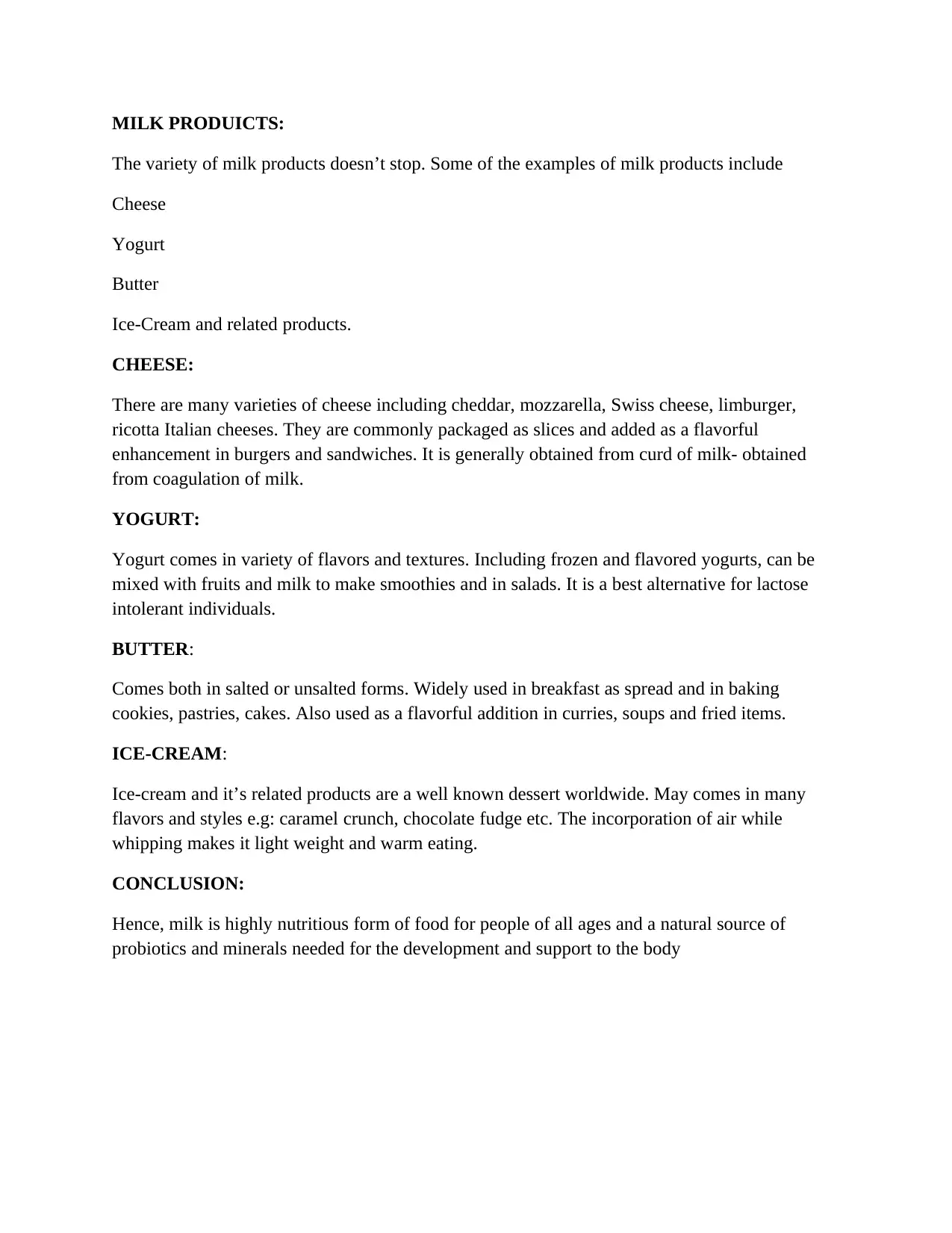
MILK PRODUICTS:
The variety of milk products doesn’t stop. Some of the examples of milk products include
Cheese
Yogurt
Butter
Ice-Cream and related products.
CHEESE:
There are many varieties of cheese including cheddar, mozzarella, Swiss cheese, limburger,
ricotta Italian cheeses. They are commonly packaged as slices and added as a flavorful
enhancement in burgers and sandwiches. It is generally obtained from curd of milk- obtained
from coagulation of milk.
YOGURT:
Yogurt comes in variety of flavors and textures. Including frozen and flavored yogurts, can be
mixed with fruits and milk to make smoothies and in salads. It is a best alternative for lactose
intolerant individuals.
BUTTER:
Comes both in salted or unsalted forms. Widely used in breakfast as spread and in baking
cookies, pastries, cakes. Also used as a flavorful addition in curries, soups and fried items.
ICE-CREAM:
Ice-cream and it’s related products are a well known dessert worldwide. May comes in many
flavors and styles e.g: caramel crunch, chocolate fudge etc. The incorporation of air while
whipping makes it light weight and warm eating.
CONCLUSION:
Hence, milk is highly nutritious form of food for people of all ages and a natural source of
probiotics and minerals needed for the development and support to the body
The variety of milk products doesn’t stop. Some of the examples of milk products include
Cheese
Yogurt
Butter
Ice-Cream and related products.
CHEESE:
There are many varieties of cheese including cheddar, mozzarella, Swiss cheese, limburger,
ricotta Italian cheeses. They are commonly packaged as slices and added as a flavorful
enhancement in burgers and sandwiches. It is generally obtained from curd of milk- obtained
from coagulation of milk.
YOGURT:
Yogurt comes in variety of flavors and textures. Including frozen and flavored yogurts, can be
mixed with fruits and milk to make smoothies and in salads. It is a best alternative for lactose
intolerant individuals.
BUTTER:
Comes both in salted or unsalted forms. Widely used in breakfast as spread and in baking
cookies, pastries, cakes. Also used as a flavorful addition in curries, soups and fried items.
ICE-CREAM:
Ice-cream and it’s related products are a well known dessert worldwide. May comes in many
flavors and styles e.g: caramel crunch, chocolate fudge etc. The incorporation of air while
whipping makes it light weight and warm eating.
CONCLUSION:
Hence, milk is highly nutritious form of food for people of all ages and a natural source of
probiotics and minerals needed for the development and support to the body
Paraphrase This Document
Need a fresh take? Get an instant paraphrase of this document with our AI Paraphraser
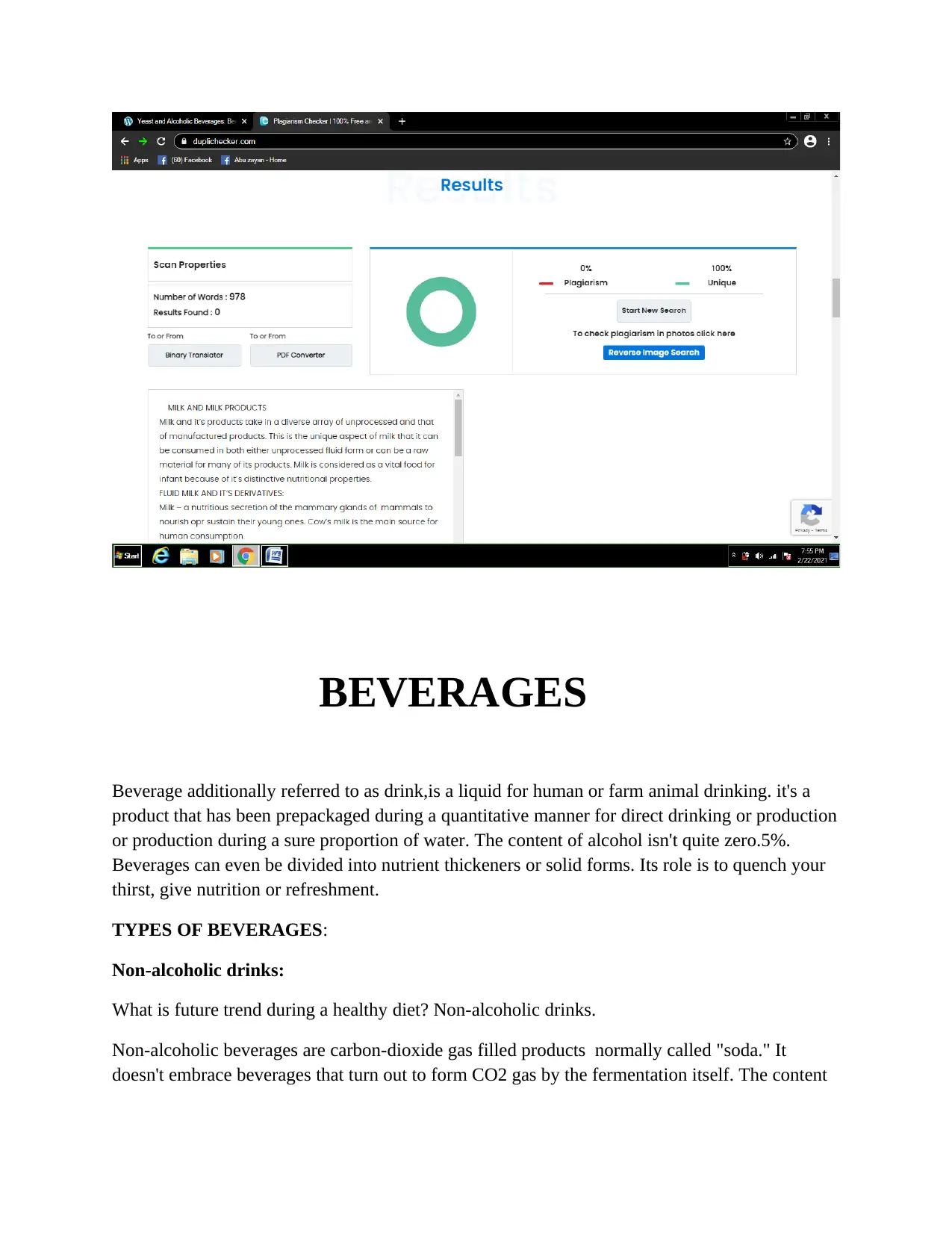
BEVERAGES
Beverage additionally referred to as drink,is a liquid for human or farm animal drinking. it's a
product that has been prepackaged during a quantitative manner for direct drinking or production
or production during a sure proportion of water. The content of alcohol isn't quite zero.5%.
Beverages can even be divided into nutrient thickeners or solid forms. Its role is to quench your
thirst, give nutrition or refreshment.
TYPES OF BEVERAGES:
Non-alcoholic drinks:
What is future trend during a healthy diet? Non-alcoholic drinks.
Non-alcoholic beverages are carbon-dioxide gas filled products normally called "soda." It
doesn't embrace beverages that turn out to form CO2 gas by the fermentation itself. The content
Beverage additionally referred to as drink,is a liquid for human or farm animal drinking. it's a
product that has been prepackaged during a quantitative manner for direct drinking or production
or production during a sure proportion of water. The content of alcohol isn't quite zero.5%.
Beverages can even be divided into nutrient thickeners or solid forms. Its role is to quench your
thirst, give nutrition or refreshment.
TYPES OF BEVERAGES:
Non-alcoholic drinks:
What is future trend during a healthy diet? Non-alcoholic drinks.
Non-alcoholic beverages are carbon-dioxide gas filled products normally called "soda." It
doesn't embrace beverages that turn out to form CO2 gas by the fermentation itself. The content
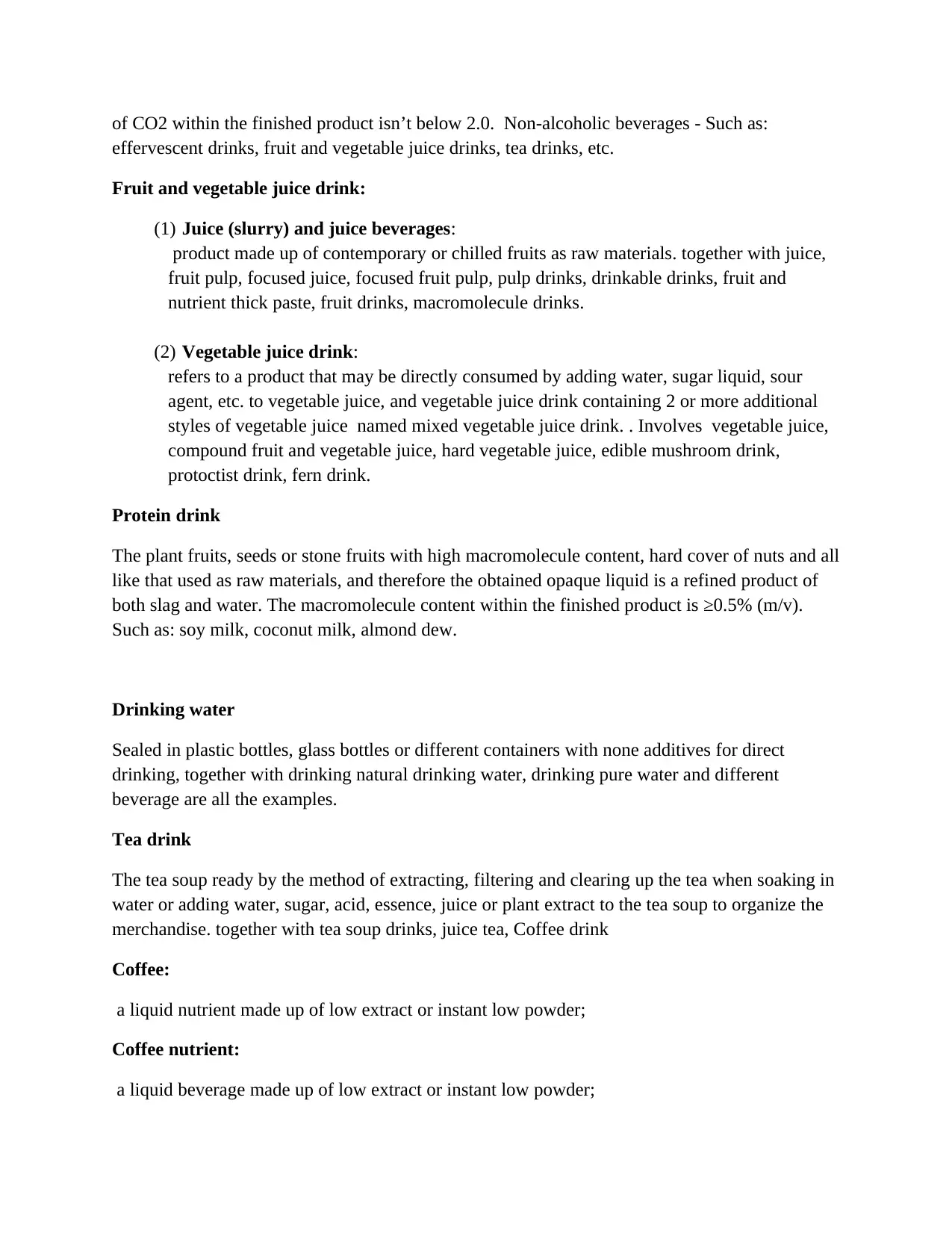
of CO2 within the finished product isn’t below 2.0. Non-alcoholic beverages - Such as:
effervescent drinks, fruit and vegetable juice drinks, tea drinks, etc.
Fruit and vegetable juice drink:
(1) Juice (slurry) and juice beverages:
product made up of contemporary or chilled fruits as raw materials. together with juice,
fruit pulp, focused juice, focused fruit pulp, pulp drinks, drinkable drinks, fruit and
nutrient thick paste, fruit drinks, macromolecule drinks.
(2) Vegetable juice drink:
refers to a product that may be directly consumed by adding water, sugar liquid, sour
agent, etc. to vegetable juice, and vegetable juice drink containing 2 or more additional
styles of vegetable juice named mixed vegetable juice drink. . Involves vegetable juice,
compound fruit and vegetable juice, hard vegetable juice, edible mushroom drink,
protoctist drink, fern drink.
Protein drink
The plant fruits, seeds or stone fruits with high macromolecule content, hard cover of nuts and all
like that used as raw materials, and therefore the obtained opaque liquid is a refined product of
both slag and water. The macromolecule content within the finished product is ≥0.5% (m/v).
Such as: soy milk, coconut milk, almond dew.
Drinking water
Sealed in plastic bottles, glass bottles or different containers with none additives for direct
drinking, together with drinking natural drinking water, drinking pure water and different
beverage are all the examples.
Tea drink
The tea soup ready by the method of extracting, filtering and clearing up the tea when soaking in
water or adding water, sugar, acid, essence, juice or plant extract to the tea soup to organize the
merchandise. together with tea soup drinks, juice tea, Coffee drink
Coffee:
a liquid nutrient made up of low extract or instant low powder;
Coffee nutrient:
a liquid beverage made up of low extract or instant low powder;
effervescent drinks, fruit and vegetable juice drinks, tea drinks, etc.
Fruit and vegetable juice drink:
(1) Juice (slurry) and juice beverages:
product made up of contemporary or chilled fruits as raw materials. together with juice,
fruit pulp, focused juice, focused fruit pulp, pulp drinks, drinkable drinks, fruit and
nutrient thick paste, fruit drinks, macromolecule drinks.
(2) Vegetable juice drink:
refers to a product that may be directly consumed by adding water, sugar liquid, sour
agent, etc. to vegetable juice, and vegetable juice drink containing 2 or more additional
styles of vegetable juice named mixed vegetable juice drink. . Involves vegetable juice,
compound fruit and vegetable juice, hard vegetable juice, edible mushroom drink,
protoctist drink, fern drink.
Protein drink
The plant fruits, seeds or stone fruits with high macromolecule content, hard cover of nuts and all
like that used as raw materials, and therefore the obtained opaque liquid is a refined product of
both slag and water. The macromolecule content within the finished product is ≥0.5% (m/v).
Such as: soy milk, coconut milk, almond dew.
Drinking water
Sealed in plastic bottles, glass bottles or different containers with none additives for direct
drinking, together with drinking natural drinking water, drinking pure water and different
beverage are all the examples.
Tea drink
The tea soup ready by the method of extracting, filtering and clearing up the tea when soaking in
water or adding water, sugar, acid, essence, juice or plant extract to the tea soup to organize the
merchandise. together with tea soup drinks, juice tea, Coffee drink
Coffee:
a liquid nutrient made up of low extract or instant low powder;
Coffee nutrient:
a liquid beverage made up of low extract or instant low powder;
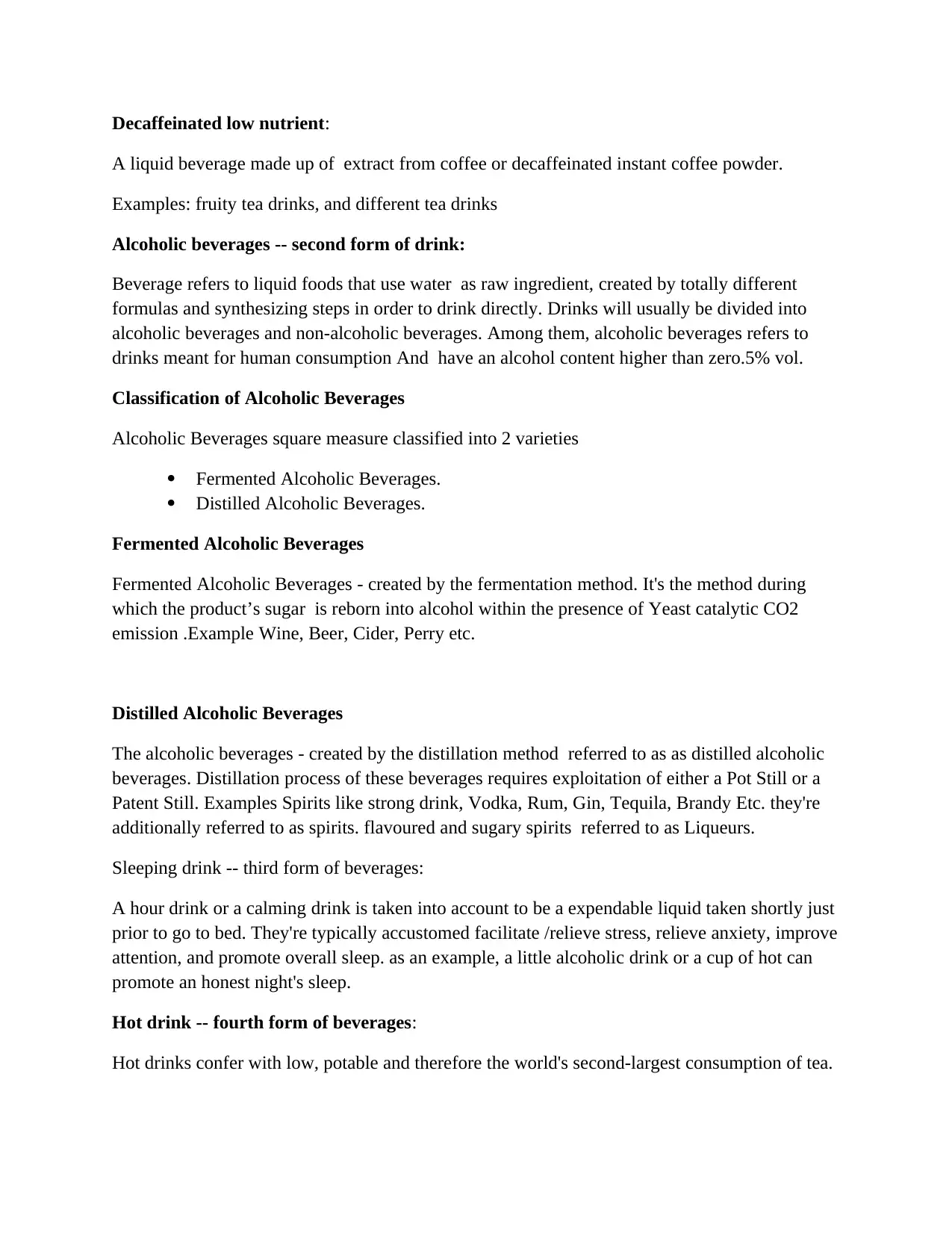
Decaffeinated low nutrient:
A liquid beverage made up of extract from coffee or decaffeinated instant coffee powder.
Examples: fruity tea drinks, and different tea drinks
Alcoholic beverages -- second form of drink:
Beverage refers to liquid foods that use water as raw ingredient, created by totally different
formulas and synthesizing steps in order to drink directly. Drinks will usually be divided into
alcoholic beverages and non-alcoholic beverages. Among them, alcoholic beverages refers to
drinks meant for human consumption And have an alcohol content higher than zero.5% vol.
Classification of Alcoholic Beverages
Alcoholic Beverages square measure classified into 2 varieties
Fermented Alcoholic Beverages.
Distilled Alcoholic Beverages.
Fermented Alcoholic Beverages
Fermented Alcoholic Beverages - created by the fermentation method. It's the method during
which the product’s sugar is reborn into alcohol within the presence of Yeast catalytic CO2
emission .Example Wine, Beer, Cider, Perry etc.
Distilled Alcoholic Beverages
The alcoholic beverages - created by the distillation method referred to as as distilled alcoholic
beverages. Distillation process of these beverages requires exploitation of either a Pot Still or a
Patent Still. Examples Spirits like strong drink, Vodka, Rum, Gin, Tequila, Brandy Etc. they're
additionally referred to as spirits. flavoured and sugary spirits referred to as Liqueurs.
Sleeping drink -- third form of beverages:
A hour drink or a calming drink is taken into account to be a expendable liquid taken shortly just
prior to go to bed. They're typically accustomed facilitate /relieve stress, relieve anxiety, improve
attention, and promote overall sleep. as an example, a little alcoholic drink or a cup of hot can
promote an honest night's sleep.
Hot drink -- fourth form of beverages:
Hot drinks confer with low, potable and therefore the world's second-largest consumption of tea.
A liquid beverage made up of extract from coffee or decaffeinated instant coffee powder.
Examples: fruity tea drinks, and different tea drinks
Alcoholic beverages -- second form of drink:
Beverage refers to liquid foods that use water as raw ingredient, created by totally different
formulas and synthesizing steps in order to drink directly. Drinks will usually be divided into
alcoholic beverages and non-alcoholic beverages. Among them, alcoholic beverages refers to
drinks meant for human consumption And have an alcohol content higher than zero.5% vol.
Classification of Alcoholic Beverages
Alcoholic Beverages square measure classified into 2 varieties
Fermented Alcoholic Beverages.
Distilled Alcoholic Beverages.
Fermented Alcoholic Beverages
Fermented Alcoholic Beverages - created by the fermentation method. It's the method during
which the product’s sugar is reborn into alcohol within the presence of Yeast catalytic CO2
emission .Example Wine, Beer, Cider, Perry etc.
Distilled Alcoholic Beverages
The alcoholic beverages - created by the distillation method referred to as as distilled alcoholic
beverages. Distillation process of these beverages requires exploitation of either a Pot Still or a
Patent Still. Examples Spirits like strong drink, Vodka, Rum, Gin, Tequila, Brandy Etc. they're
additionally referred to as spirits. flavoured and sugary spirits referred to as Liqueurs.
Sleeping drink -- third form of beverages:
A hour drink or a calming drink is taken into account to be a expendable liquid taken shortly just
prior to go to bed. They're typically accustomed facilitate /relieve stress, relieve anxiety, improve
attention, and promote overall sleep. as an example, a little alcoholic drink or a cup of hot can
promote an honest night's sleep.
Hot drink -- fourth form of beverages:
Hot drinks confer with low, potable and therefore the world's second-largest consumption of tea.
Secure Best Marks with AI Grader
Need help grading? Try our AI Grader for instant feedback on your assignments.
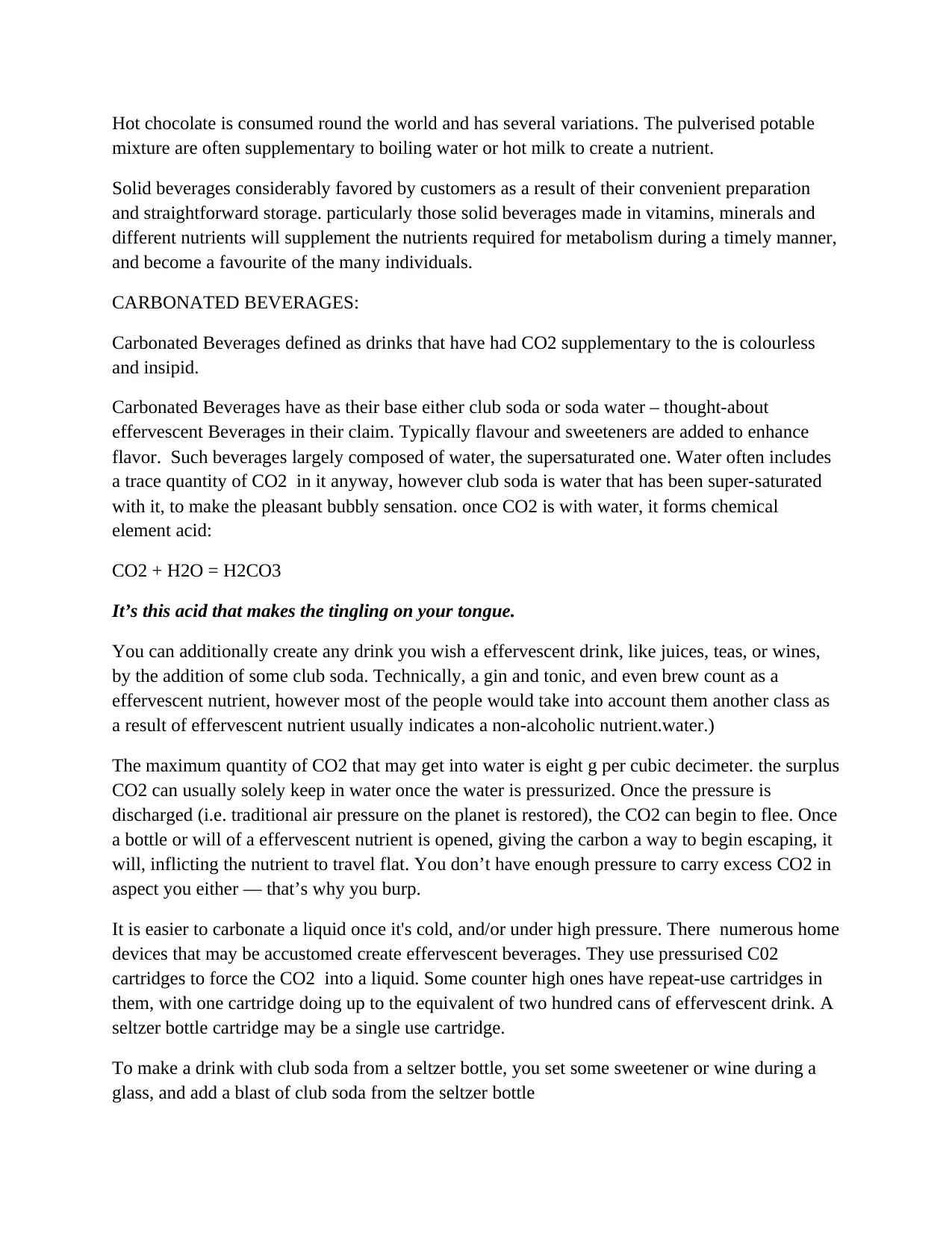
Hot chocolate is consumed round the world and has several variations. The pulverised potable
mixture are often supplementary to boiling water or hot milk to create a nutrient.
Solid beverages considerably favored by customers as a result of their convenient preparation
and straightforward storage. particularly those solid beverages made in vitamins, minerals and
different nutrients will supplement the nutrients required for metabolism during a timely manner,
and become a favourite of the many individuals.
CARBONATED BEVERAGES:
Carbonated Beverages defined as drinks that have had CO2 supplementary to the is colourless
and insipid.
Carbonated Beverages have as their base either club soda or soda water – thought-about
effervescent Beverages in their claim. Typically flavour and sweeteners are added to enhance
flavor. Such beverages largely composed of water, the supersaturated one. Water often includes
a trace quantity of CO2 in it anyway, however club soda is water that has been super-saturated
with it, to make the pleasant bubbly sensation. once CO2 is with water, it forms chemical
element acid:
CO2 + H2O = H2CO3
It’s this acid that makes the tingling on your tongue.
You can additionally create any drink you wish a effervescent drink, like juices, teas, or wines,
by the addition of some club soda. Technically, a gin and tonic, and even brew count as a
effervescent nutrient, however most of the people would take into account them another class as
a result of effervescent nutrient usually indicates a non-alcoholic nutrient.water.)
The maximum quantity of CO2 that may get into water is eight g per cubic decimeter. the surplus
CO2 can usually solely keep in water once the water is pressurized. Once the pressure is
discharged (i.e. traditional air pressure on the planet is restored), the CO2 can begin to flee. Once
a bottle or will of a effervescent nutrient is opened, giving the carbon a way to begin escaping, it
will, inflicting the nutrient to travel flat. You don’t have enough pressure to carry excess CO2 in
aspect you either — that’s why you burp.
It is easier to carbonate a liquid once it's cold, and/or under high pressure. There numerous home
devices that may be accustomed create effervescent beverages. They use pressurised C02
cartridges to force the CO2 into a liquid. Some counter high ones have repeat-use cartridges in
them, with one cartridge doing up to the equivalent of two hundred cans of effervescent drink. A
seltzer bottle cartridge may be a single use cartridge.
To make a drink with club soda from a seltzer bottle, you set some sweetener or wine during a
glass, and add a blast of club soda from the seltzer bottle
mixture are often supplementary to boiling water or hot milk to create a nutrient.
Solid beverages considerably favored by customers as a result of their convenient preparation
and straightforward storage. particularly those solid beverages made in vitamins, minerals and
different nutrients will supplement the nutrients required for metabolism during a timely manner,
and become a favourite of the many individuals.
CARBONATED BEVERAGES:
Carbonated Beverages defined as drinks that have had CO2 supplementary to the is colourless
and insipid.
Carbonated Beverages have as their base either club soda or soda water – thought-about
effervescent Beverages in their claim. Typically flavour and sweeteners are added to enhance
flavor. Such beverages largely composed of water, the supersaturated one. Water often includes
a trace quantity of CO2 in it anyway, however club soda is water that has been super-saturated
with it, to make the pleasant bubbly sensation. once CO2 is with water, it forms chemical
element acid:
CO2 + H2O = H2CO3
It’s this acid that makes the tingling on your tongue.
You can additionally create any drink you wish a effervescent drink, like juices, teas, or wines,
by the addition of some club soda. Technically, a gin and tonic, and even brew count as a
effervescent nutrient, however most of the people would take into account them another class as
a result of effervescent nutrient usually indicates a non-alcoholic nutrient.water.)
The maximum quantity of CO2 that may get into water is eight g per cubic decimeter. the surplus
CO2 can usually solely keep in water once the water is pressurized. Once the pressure is
discharged (i.e. traditional air pressure on the planet is restored), the CO2 can begin to flee. Once
a bottle or will of a effervescent nutrient is opened, giving the carbon a way to begin escaping, it
will, inflicting the nutrient to travel flat. You don’t have enough pressure to carry excess CO2 in
aspect you either — that’s why you burp.
It is easier to carbonate a liquid once it's cold, and/or under high pressure. There numerous home
devices that may be accustomed create effervescent beverages. They use pressurised C02
cartridges to force the CO2 into a liquid. Some counter high ones have repeat-use cartridges in
them, with one cartridge doing up to the equivalent of two hundred cans of effervescent drink. A
seltzer bottle cartridge may be a single use cartridge.
To make a drink with club soda from a seltzer bottle, you set some sweetener or wine during a
glass, and add a blast of club soda from the seltzer bottle
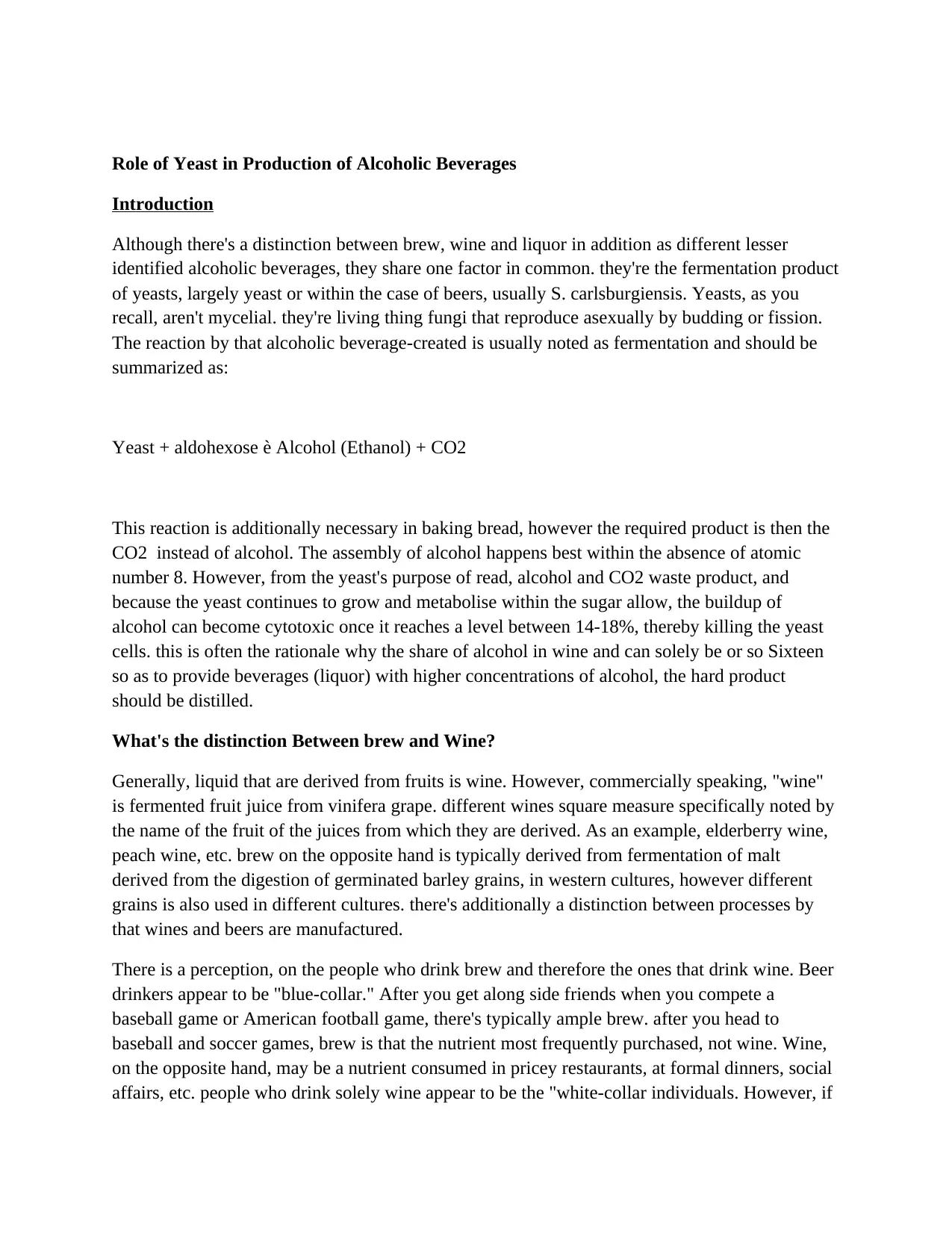
Role of Yeast in Production of Alcoholic Beverages
Introduction
Although there's a distinction between brew, wine and liquor in addition as different lesser
identified alcoholic beverages, they share one factor in common. they're the fermentation product
of yeasts, largely yeast or within the case of beers, usually S. carlsburgiensis. Yeasts, as you
recall, aren't mycelial. they're living thing fungi that reproduce asexually by budding or fission.
The reaction by that alcoholic beverage-created is usually noted as fermentation and should be
summarized as:
Yeast + aldohexose è Alcohol (Ethanol) + CO2
This reaction is additionally necessary in baking bread, however the required product is then the
CO2 instead of alcohol. The assembly of alcohol happens best within the absence of atomic
number 8. However, from the yeast's purpose of read, alcohol and CO2 waste product, and
because the yeast continues to grow and metabolise within the sugar allow, the buildup of
alcohol can become cytotoxic once it reaches a level between 14-18%, thereby killing the yeast
cells. this is often the rationale why the share of alcohol in wine and can solely be or so Sixteen
so as to provide beverages (liquor) with higher concentrations of alcohol, the hard product
should be distilled.
What's the distinction Between brew and Wine?
Generally, liquid that are derived from fruits is wine. However, commercially speaking, "wine"
is fermented fruit juice from vinifera grape. different wines square measure specifically noted by
the name of the fruit of the juices from which they are derived. As an example, elderberry wine,
peach wine, etc. brew on the opposite hand is typically derived from fermentation of malt
derived from the digestion of germinated barley grains, in western cultures, however different
grains is also used in different cultures. there's additionally a distinction between processes by
that wines and beers are manufactured.
There is a perception, on the people who drink brew and therefore the ones that drink wine. Beer
drinkers appear to be "blue-collar." After you get along side friends when you compete a
baseball game or American football game, there's typically ample brew. after you head to
baseball and soccer games, brew is that the nutrient most frequently purchased, not wine. Wine,
on the opposite hand, may be a nutrient consumed in pricey restaurants, at formal dinners, social
affairs, etc. people who drink solely wine appear to be the "white-collar individuals. However, if
Introduction
Although there's a distinction between brew, wine and liquor in addition as different lesser
identified alcoholic beverages, they share one factor in common. they're the fermentation product
of yeasts, largely yeast or within the case of beers, usually S. carlsburgiensis. Yeasts, as you
recall, aren't mycelial. they're living thing fungi that reproduce asexually by budding or fission.
The reaction by that alcoholic beverage-created is usually noted as fermentation and should be
summarized as:
Yeast + aldohexose è Alcohol (Ethanol) + CO2
This reaction is additionally necessary in baking bread, however the required product is then the
CO2 instead of alcohol. The assembly of alcohol happens best within the absence of atomic
number 8. However, from the yeast's purpose of read, alcohol and CO2 waste product, and
because the yeast continues to grow and metabolise within the sugar allow, the buildup of
alcohol can become cytotoxic once it reaches a level between 14-18%, thereby killing the yeast
cells. this is often the rationale why the share of alcohol in wine and can solely be or so Sixteen
so as to provide beverages (liquor) with higher concentrations of alcohol, the hard product
should be distilled.
What's the distinction Between brew and Wine?
Generally, liquid that are derived from fruits is wine. However, commercially speaking, "wine"
is fermented fruit juice from vinifera grape. different wines square measure specifically noted by
the name of the fruit of the juices from which they are derived. As an example, elderberry wine,
peach wine, etc. brew on the opposite hand is typically derived from fermentation of malt
derived from the digestion of germinated barley grains, in western cultures, however different
grains is also used in different cultures. there's additionally a distinction between processes by
that wines and beers are manufactured.
There is a perception, on the people who drink brew and therefore the ones that drink wine. Beer
drinkers appear to be "blue-collar." After you get along side friends when you compete a
baseball game or American football game, there's typically ample brew. after you head to
baseball and soccer games, brew is that the nutrient most frequently purchased, not wine. Wine,
on the opposite hand, may be a nutrient consumed in pricey restaurants, at formal dinners, social
affairs, etc. people who drink solely wine appear to be the "white-collar individuals. However, if
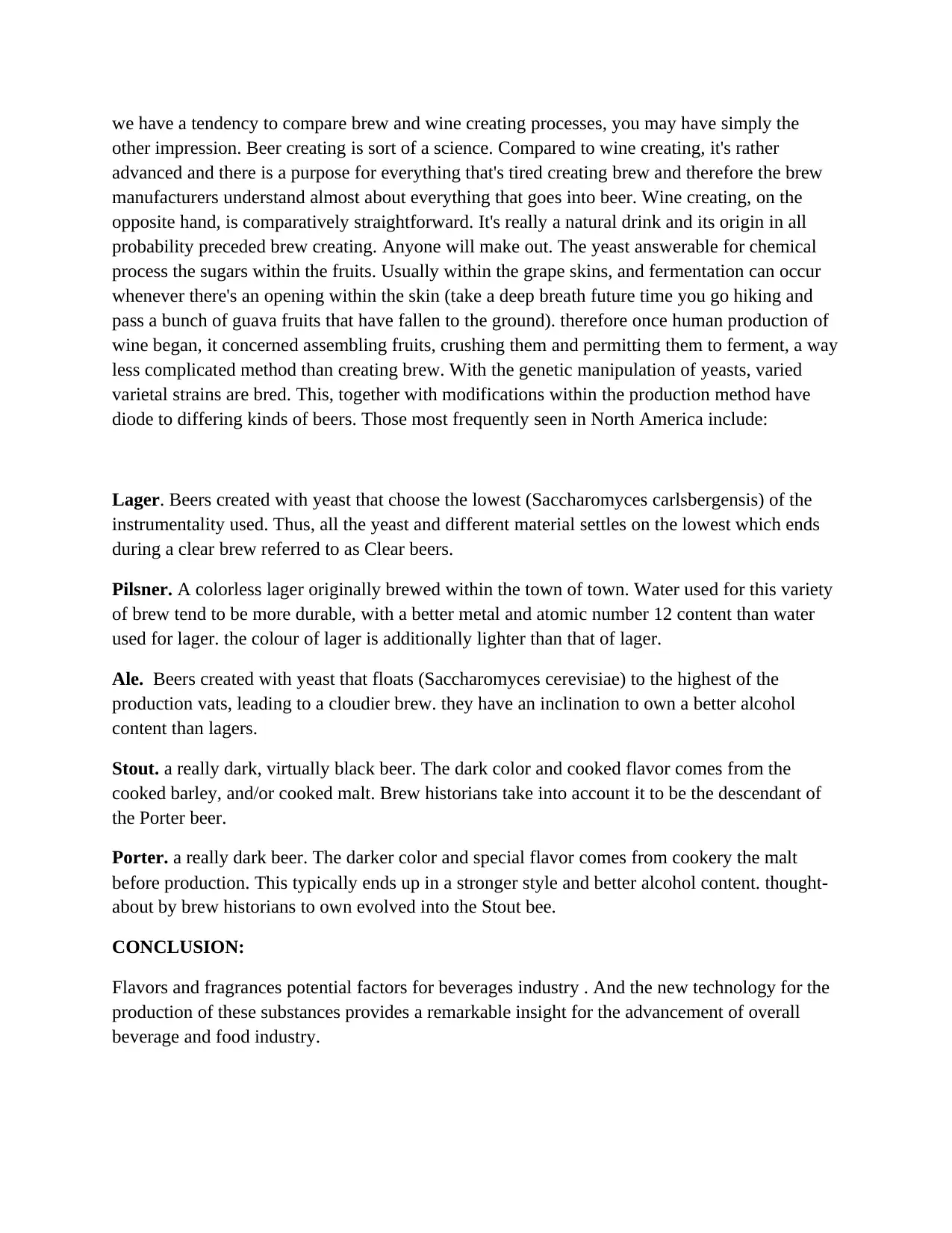
we have a tendency to compare brew and wine creating processes, you may have simply the
other impression. Beer creating is sort of a science. Compared to wine creating, it's rather
advanced and there is a purpose for everything that's tired creating brew and therefore the brew
manufacturers understand almost about everything that goes into beer. Wine creating, on the
opposite hand, is comparatively straightforward. It's really a natural drink and its origin in all
probability preceded brew creating. Anyone will make out. The yeast answerable for chemical
process the sugars within the fruits. Usually within the grape skins, and fermentation can occur
whenever there's an opening within the skin (take a deep breath future time you go hiking and
pass a bunch of guava fruits that have fallen to the ground). therefore once human production of
wine began, it concerned assembling fruits, crushing them and permitting them to ferment, a way
less complicated method than creating brew. With the genetic manipulation of yeasts, varied
varietal strains are bred. This, together with modifications within the production method have
diode to differing kinds of beers. Those most frequently seen in North America include:
Lager. Beers created with yeast that choose the lowest (Saccharomyces carlsbergensis) of the
instrumentality used. Thus, all the yeast and different material settles on the lowest which ends
during a clear brew referred to as Clear beers.
Pilsner. A colorless lager originally brewed within the town of town. Water used for this variety
of brew tend to be more durable, with a better metal and atomic number 12 content than water
used for lager. the colour of lager is additionally lighter than that of lager.
Ale. Beers created with yeast that floats (Saccharomyces cerevisiae) to the highest of the
production vats, leading to a cloudier brew. they have an inclination to own a better alcohol
content than lagers.
Stout. a really dark, virtually black beer. The dark color and cooked flavor comes from the
cooked barley, and/or cooked malt. Brew historians take into account it to be the descendant of
the Porter beer.
Porter. a really dark beer. The darker color and special flavor comes from cookery the malt
before production. This typically ends up in a stronger style and better alcohol content. thought-
about by brew historians to own evolved into the Stout bee.
CONCLUSION:
Flavors and fragrances potential factors for beverages industry . And the new technology for the
production of these substances provides a remarkable insight for the advancement of overall
beverage and food industry.
other impression. Beer creating is sort of a science. Compared to wine creating, it's rather
advanced and there is a purpose for everything that's tired creating brew and therefore the brew
manufacturers understand almost about everything that goes into beer. Wine creating, on the
opposite hand, is comparatively straightforward. It's really a natural drink and its origin in all
probability preceded brew creating. Anyone will make out. The yeast answerable for chemical
process the sugars within the fruits. Usually within the grape skins, and fermentation can occur
whenever there's an opening within the skin (take a deep breath future time you go hiking and
pass a bunch of guava fruits that have fallen to the ground). therefore once human production of
wine began, it concerned assembling fruits, crushing them and permitting them to ferment, a way
less complicated method than creating brew. With the genetic manipulation of yeasts, varied
varietal strains are bred. This, together with modifications within the production method have
diode to differing kinds of beers. Those most frequently seen in North America include:
Lager. Beers created with yeast that choose the lowest (Saccharomyces carlsbergensis) of the
instrumentality used. Thus, all the yeast and different material settles on the lowest which ends
during a clear brew referred to as Clear beers.
Pilsner. A colorless lager originally brewed within the town of town. Water used for this variety
of brew tend to be more durable, with a better metal and atomic number 12 content than water
used for lager. the colour of lager is additionally lighter than that of lager.
Ale. Beers created with yeast that floats (Saccharomyces cerevisiae) to the highest of the
production vats, leading to a cloudier brew. they have an inclination to own a better alcohol
content than lagers.
Stout. a really dark, virtually black beer. The dark color and cooked flavor comes from the
cooked barley, and/or cooked malt. Brew historians take into account it to be the descendant of
the Porter beer.
Porter. a really dark beer. The darker color and special flavor comes from cookery the malt
before production. This typically ends up in a stronger style and better alcohol content. thought-
about by brew historians to own evolved into the Stout bee.
CONCLUSION:
Flavors and fragrances potential factors for beverages industry . And the new technology for the
production of these substances provides a remarkable insight for the advancement of overall
beverage and food industry.
Paraphrase This Document
Need a fresh take? Get an instant paraphrase of this document with our AI Paraphraser


1 out of 15
Your All-in-One AI-Powered Toolkit for Academic Success.
+13062052269
info@desklib.com
Available 24*7 on WhatsApp / Email
![[object Object]](/_next/static/media/star-bottom.7253800d.svg)
Unlock your academic potential
© 2024 | Zucol Services PVT LTD | All rights reserved.
